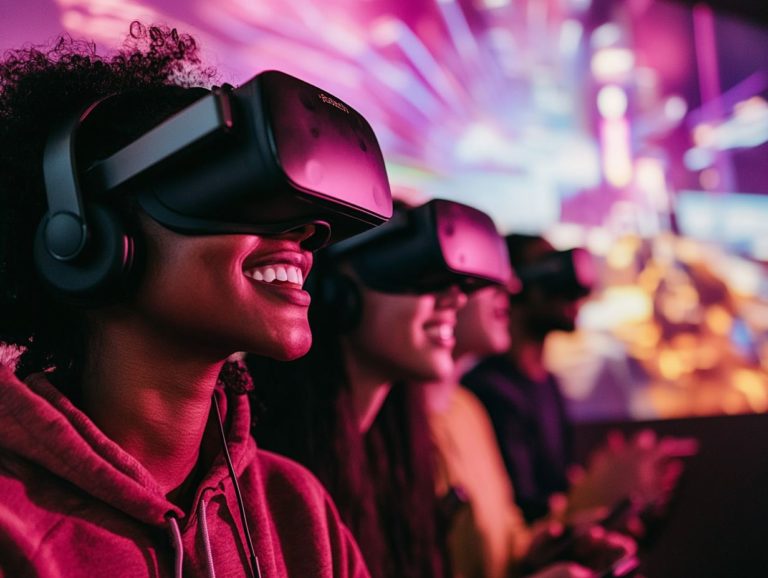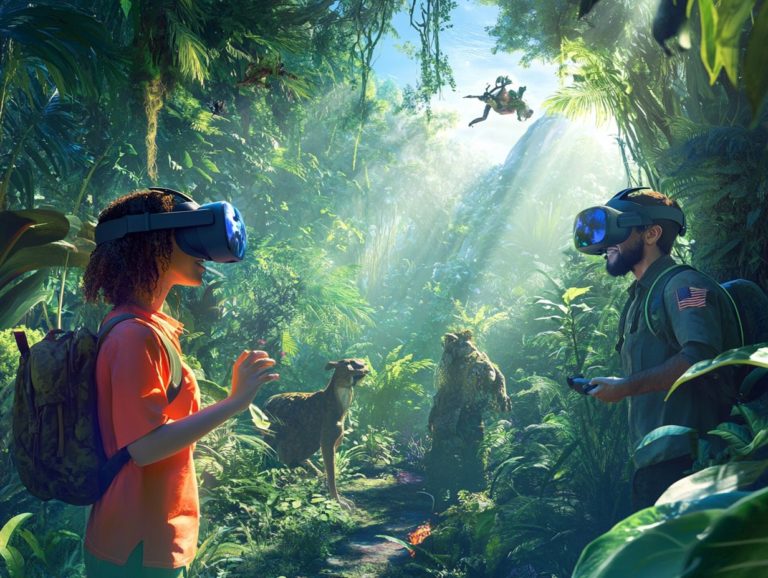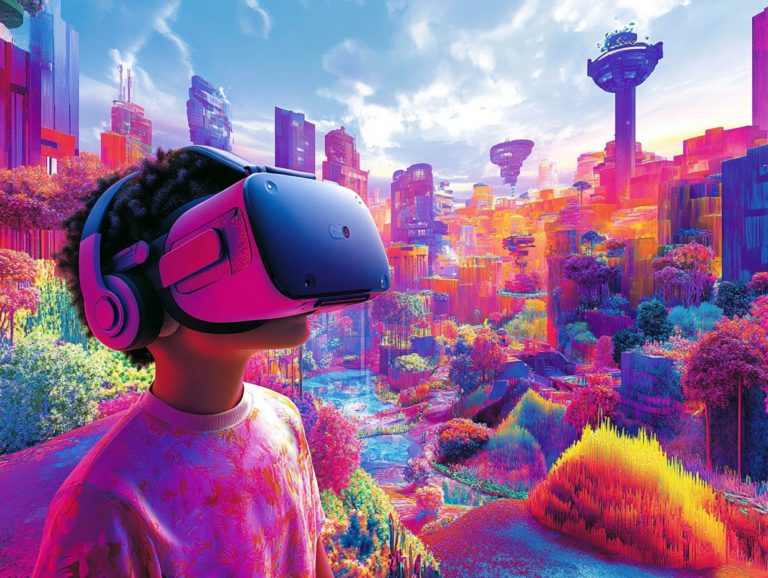vr equipment for beginners: what you should know
Get ready to dive into the exciting world of VR that transforms how you enjoy digital content! Virtual reality (VR) immerses you in engaging worlds that captivate your senses like never before.
If you’re a beginner, the landscape of VR equipment might seem overwhelming. This guide makes it easy to jump right into the VR world by breaking down the different types of gear, from headsets to controllers and tracking systems.
It highlights essential factors to consider before making a purchase, provides a step-by-step setup guide, and shares best practices to enhance your VR experience.
Whether you re a casual gamer or a tech enthusiast, this guide empowers you to make informed decisions and fully embrace the wonders that VR has to offer.
Contents
Key Takeaways:

- Invest in a comfortable and compatible VR headset that fits your budget.
- Choose controllers and tracking systems that enhance your experience.
- Set up your VR equipment by following a step-by-step guide for optimal performance.
- Maintain hygiene and take breaks to prevent motion sickness.
- Before purchasing, research and consider factors such as budget, compatibility, and comfort, as these greatly impact your overall experience as a beginner in VR.
What is VR?
Virtual reality (VR) stands at the forefront of technological innovation, immersing you in carefully designed digital environments that feel astonishingly real.
With VR headsets, controllers, and advanced tracking systems, you can engage with 3D spaces in ways that redefine gaming and simulation.
The degrees of freedom available can turn ordinary experiences into captivating adventures. Thanks to advancements in spatial audio, the feeling of truly being ‘inside’ the virtual realm is amplified, making VR an essential part of contemporary gaming and simulation experiences.
Types of VR Equipment
The landscape of VR equipment features a variety of headsets, controllers, and tracking systems carefully designed for both gamers and simulation enthusiasts.
Explore the popular Meta Quest, Oculus Rift, Valve Index, or the sophistication of PICO headsets; each platform offers distinct specifications and user experiences for immersive gameplay.
Controllers are essential for interaction, while tracking systems monitor your movements in VR, elevating your entire experience.
Headsets
VR headsets serve as your primary gateway to the world of virtual reality, offering an expansive field of view and advanced tracking capabilities that truly enhance your experience.
Popular models like the Meta Quest, Oculus Rift, Valve Index, and PICO each provide unique features tailored to your gaming preferences, whether you’re a casual player or a high-end simulation enthusiast.
These devices vary significantly in specifications, particularly in their field of view, which can dramatically enhance your sense of immersion. For instance, the Valve Index offers a wider field of view than its competitors, enveloping you in a more captivating visual experience.
Tracking technology also differs; some headsets utilize outside-in sensors for precise movement detection, while others employ inside-out tracking for added convenience. Comfort features, such as adjustable straps and ergonomic designs, are crucial for long gaming sessions, ensuring you remain comfortable while fully engaged.
Ultimately, your choice among these headsets will depend on finding the right balance between features and personal comfort, as each model shapes your virtual journey in its own unique way.
Controllers
Controllers are vital for VR systems. They let you interact seamlessly within virtual environments and enhance immersion.
VR controllers offer capabilities from basic motion tracking (3DoF) to advanced tracking (6DoF). This allows a more intuitive connection to the virtual world.
Devices come in many forms, like handheld wands, glove systems, and full-body suits, each designed for different interactions.
Handheld wands have touch-sensitive buttons, motion sensors, and haptic feedback. This allows you to manipulate objects and engage in combat with precision.
Glove systems enable detailed finger movements, making interactions feel lifelike.
Tracking technologies capture your movements and translate them into the virtual space. Accurate tracking creates an engaging atmosphere that feels authentic.
Sensors and Tracking Systems
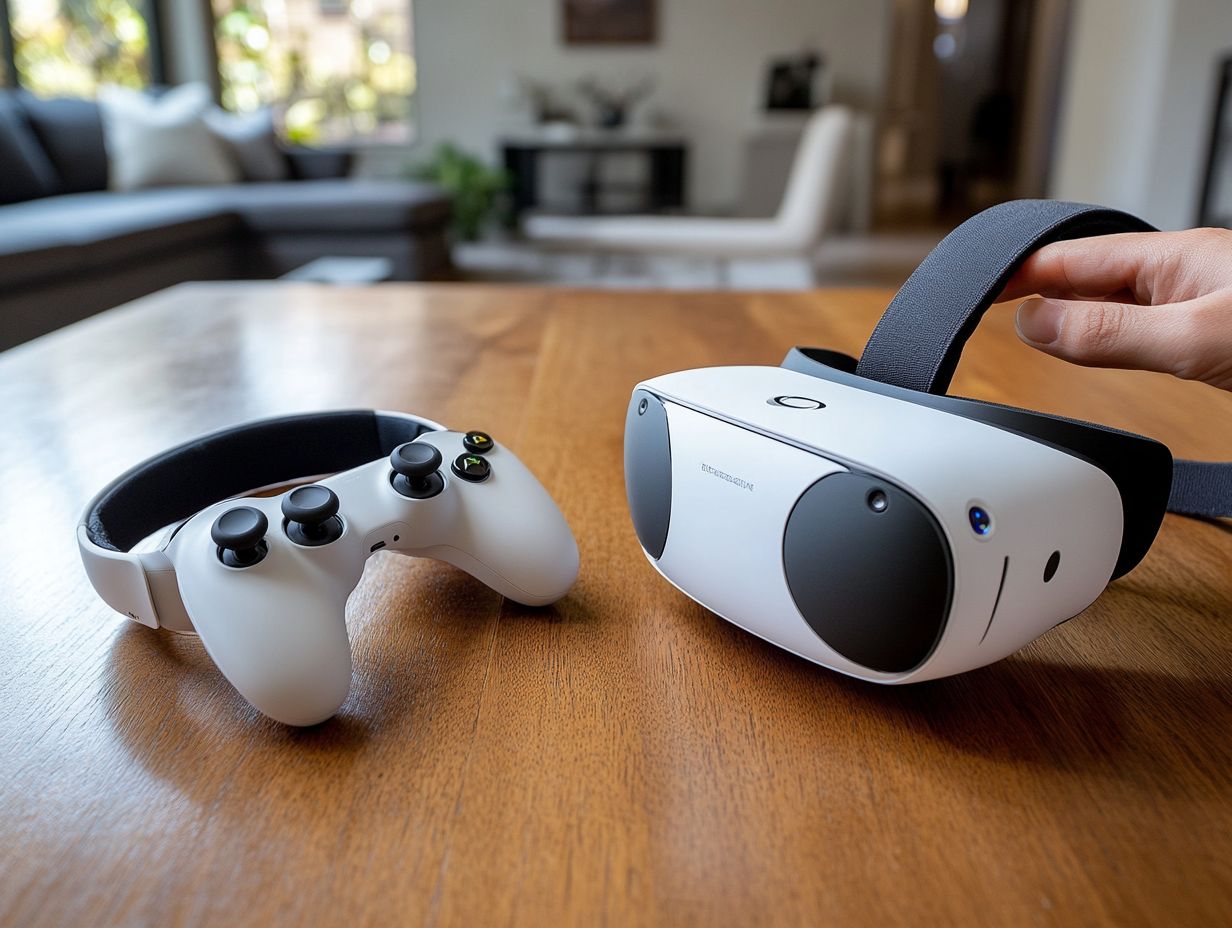
Tracking systems are essential for capturing your movements in VR. This elevates your sense of immersion and interactivity.
There are two primary types of tracking. Inside-out tracking uses cameras on the headset, while outside-in tracking relies on external sensors.
These systems use special cameras and algorithms to mirror even the slightest motions in the virtual world. This precision is crucial for comfort, as poor tracking can cause motion sickness.
Effective tracking also enhances spatial audio, creating a dynamic sound experience that syncs with your movements. This significantly influences your overall enjoyment of the virtual worlds.
Factors to Consider Before Buying VR Equipment
Before investing in VR gear, consider key factors that impact your experience. Look at your budget, compatibility with existing systems, and comfort settings.
Choosing a VR headset and controllers that match your preferences can minimize motion sickness and improve overall satisfaction.
Budget
Setting a budget for VR equipment is essential. Prices can vary greatly among different headsets and controllers, from budget-friendly options like PlayStation VR to high-end devices like the HTC Vive.
Understanding the features at each price point helps you make informed choices. For mid-range options, the Oculus Quest offers a good balance of quality and price, with wireless capabilities and a vast game library.
If you’re ready to invest more, premium brands provide superior tracking and enhanced graphics for a more immersive experience. Don’t forget to include potential extra costs for compatible PCs or accessories in your budget.
By evaluating your preferences and intended use, you’ll navigate the VR landscape more effectively and choose equipment that enhances your adventures.
Compatibility
Compatibility is a crucial factor when diving into the world of VR headsets and controllers. Not all devices work seamlessly with every gaming system or computer.
Ensure your chosen VR setup matches your gaming hardware whether it s a PC, console, or standalone device to avoid frustrations and enhance your experience.
First, check the specific system requirements for the VR headset and your gaming platform. This includes the main parts of your computer that help it run games smoothly: CPU, GPU, and RAM.
Compatibility also includes software requirements. Some VR applications may need the latest operating system updates. Many gaming consoles come with dedicated VR systems for optimal performance, while if you re a PC user, ensure your hardware meets the recommended benchmarks.
Understanding these parameters helps you avoid costly mistakes and ensures a smooth and immersive gaming adventure.
Comfort and Fit
The comfort and fit of VR headsets are essential for an enjoyable experience. Poorly fitting gear can lead to discomfort or even motion sickness.
To achieve an immersive experience, pay attention to features like adjustable straps, padding, and weight distribution when selecting your headset. A well-fitted headset allows for longer gaming or exploration sessions without strain or distraction.
Try on several models to find one that feels snug yet comfortable. Also, consider breathability; heat buildup can cause irritation. Look for soft, hypoallergenic padding to enhance your overall experience.
Keep an eye on the headset’s weight to avoid neck fatigue after extended use. These factors are crucial for your virtual adventures, ensuring every moment in the virtual world is enjoyable.
Setting Up Your VR Equipment
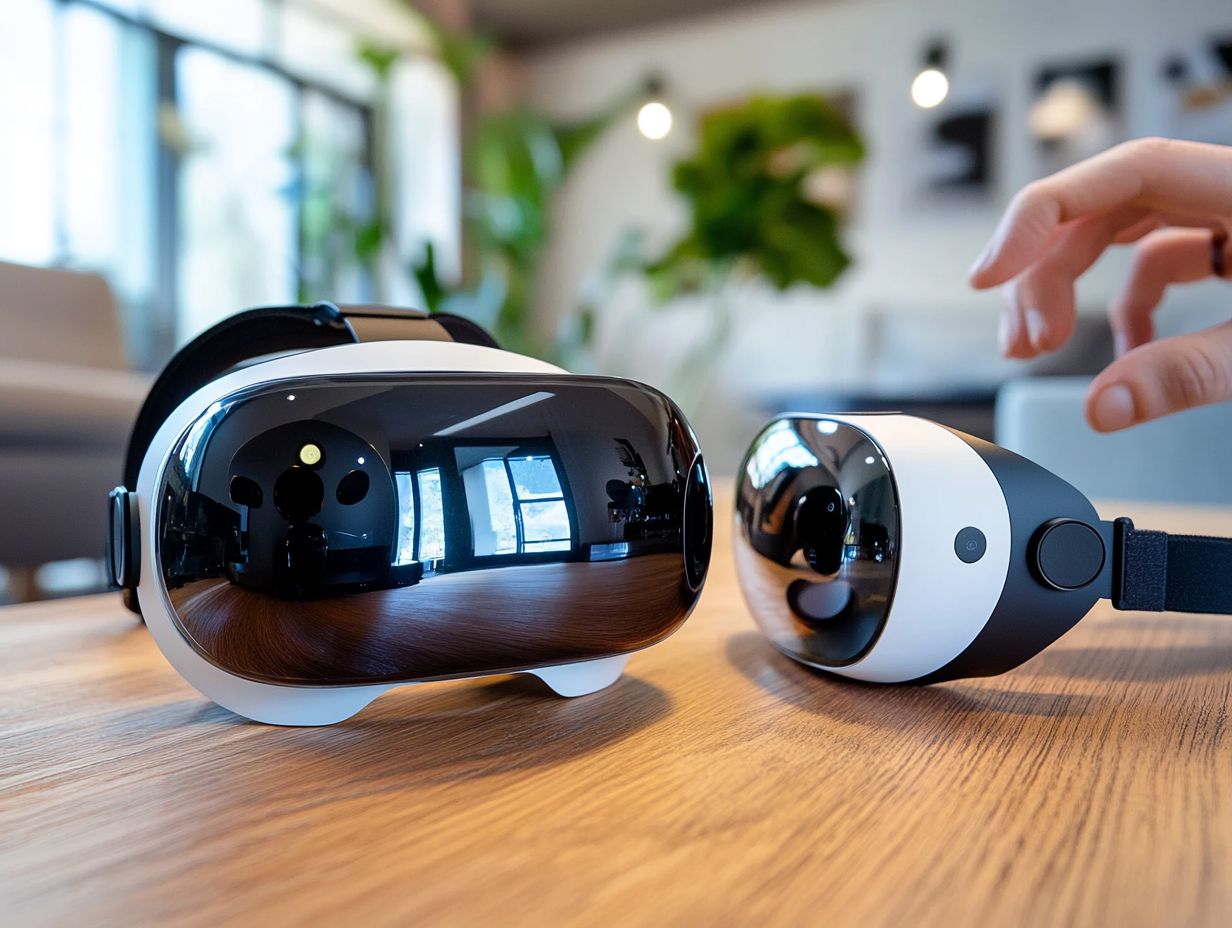
Setting up your VR gear correctly is key for optimal performance and an immersive experience. This includes careful sensor placement, headset adjustments, and calibration of tracking systems.
A well-configured setup enhances interaction and minimizes motion sickness, allowing you to embark on an extraordinary journey into virtual environments.
Step-by-Step Guide
A successful VR setup involves several key steps to ensure all components work together seamlessly for the ultimate immersive experience.
- Start by selecting an appropriate space with ample room for movement, then position the sensors correctly, configure the headset, and calibrate the tracking systems.
- Choose a well-lit area with minimal obstructions for a safe range of movement.
- Place the sensors at optimal points for tracking accuracy; typically, set them high on walls for a broader field of view.
- Unpack the headset and connect it to your computer, ensuring all cables are securely fastened.
- You must calibrate your setup carefully, following the on-screen instructions to adjust the tracking settings and accurately map your physical environment.
- If you encounter issues like tracking discrepancies or connectivity problems, check each sensor s indicator lights, ensuring no obstacles obstruct their line of sight.
- Regularly update your VR software to prevent glitches and enhance performance, transforming your experience into something remarkable.
Best Practices for Using VR Equipment
For a captivating VR experience, embrace best practices that enhance comfort, minimize the risk of motion sickness, and maintain hygiene standards.
By adhering to these guidelines, you can ensure a safer, more enjoyable VR journey, allowing you to delve deeper into the enchanting realms of virtual worlds.
So gear up and dive into the exciting world of virtual reality your adventure awaits!
Maintaining Hygiene
Maintaining hygiene in VR is vital for ensuring your safety and comfort, especially when sharing equipment with others. Regularly cleaning headsets, controllers, and accessories can significantly reduce the buildup of germs and elevate your immersive experience.
To achieve this level of cleanliness, establish a consistent cleaning routine. Start by using microfiber cloths that are lightly dampened with a mixture of water and a type of cleaning alcohol that kills germs; this combination effectively eliminates bacteria while keeping sensitive components safe.
When using shared devices, implementing a cleaning protocol after each session is a smart move to protect yourself from potential allergens or contaminants. Don’t forget to use disposable face covers for headsets to create a barrier between you and the equipment.
Always remember to choose cleaning products that are safe for electronics and avoid excessive moisture, as this can lead to damage. By prioritizing hygiene, you not only safeguard your device but also enhance the VR experience for everyone involved. Start your VR journey today with a clean and safe setup!
Preventing Motion Sickness
Preventing motion sickness is crucial for fully enjoying your VR experience, as the disconnect between real and virtual movement can lead to discomfort.
To mitigate these effects, adjust your comfort settings, take regular breaks, and gradually acclimate to the VR environments. After these initial steps, pace yourself during gameplay and choose VR experiences designed with smoother transitions and less rapid movement.
Incorporating specific VR exercises, like opting for stationary or seated modes, can also help reduce disorientation. Pay close attention to how your body feels! If you start to feel uncomfortable, take a moment to pause and consider lowering the intensity or duration of your sessions.
By listening to your body and making these adjustments, you can cultivate a more enjoyable and immersive virtual reality experience without the unwelcome side effects of motion sickness.
Frequently Asked Questions
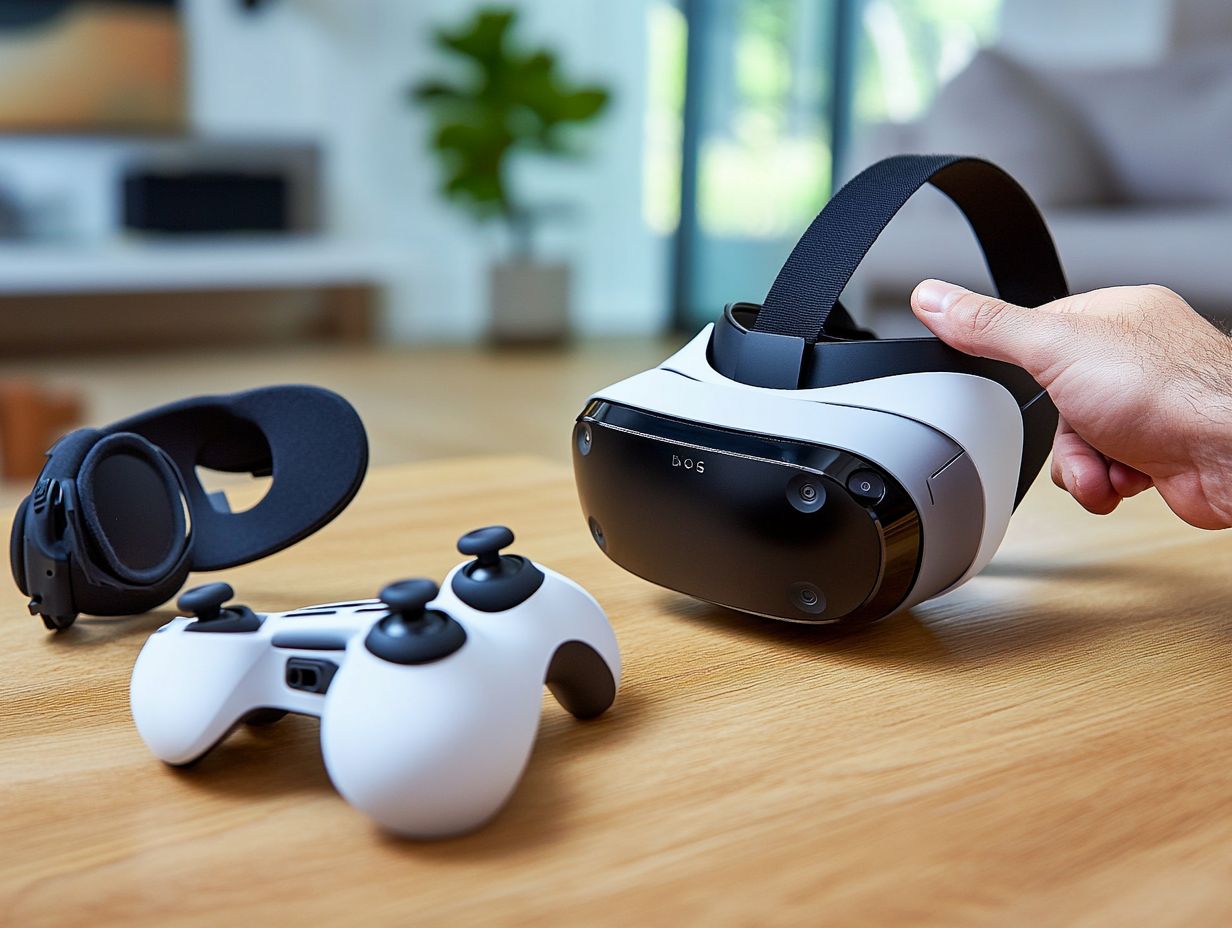
What is VR equipment for beginners?
VR equipment for beginners refers to the technology and devices used to experience virtual reality (VR) for individuals who are new to this technology. This can include VR headsets, controllers, and other accessories that allow users to fully immerse themselves in a virtual environment.
What are the different types of VR equipment for beginners?
The most commonly used VR equipment for beginners includes VR headsets, which can be categorized as either tethered, standalone, or mobile. Tethered headsets require a connection to a computer, while standalone headsets have their own processors and do not require a separate device. Mobile headsets use smartphones to display VR content. Other types of VR equipment include hand controllers and haptic feedback devices.
What should I consider when choosing VR equipment for beginners?
When choosing VR equipment for beginners, it is important to consider factors such as price, compatibility with your device, comfort, and overall experience. Additionally, it’s wise to understand what to look for in VR equipment by reading reviews and trying out different options before making a purchase to ensure it meets your needs and preferences.
Do I need a powerful computer to use VR equipment for beginners?
It depends on the type of VR headset you choose. Tethered headsets require a powerful computer to run VR content, while standalone and mobile headsets have their own processors and do not require a separate device. It is important to check the minimum system requirements before purchasing any VR equipment.
Are there any potential health risks associated with using VR equipment for beginners?
Some individuals may experience symptoms such as nausea, dizziness, and eye strain when using VR equipment. This is known as simulator sickness and can be reduced by taking breaks and adjusting the settings on your VR device. It is also recommended to consult with a doctor if you have pre-existing medical conditions before using VR equipment.
Can I use VR equipment for beginners for purposes other than gaming?
Yes, VR equipment for beginners can be used for a variety of purposes such as educational and training simulations, virtual tours, and even therapy. There are also VR applications and experiences available for entertainment, socializing, and productivity.

